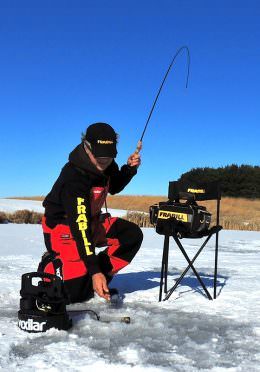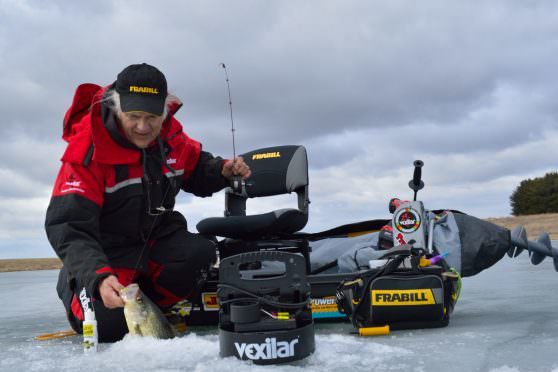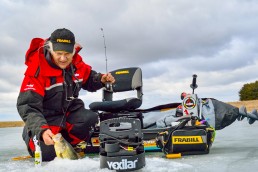Ice Combos: Which Style?
SHARE THIS POST
For many years ice fishing rod/reel combos didn’t have reels—they were just a rod with a couple of cleats on which the line was wound. And if fishing deep, fish were brought in by hand-over-hand handling of the line. But things have changed from using plastic horizontal reels to hi-tech spinning and straight-line reels.
The question is, which style should be used, and when?
The old-style combos can still be used, especially in shallower water. However, my preference for all water is either a spinning, straight-line or a Jiggler rig, which has some of the older features.

Two main factors determine the style of combo: size of fish targeted and depth of water. Larger fish require more playing ability and the deeper water requires something that can get down to the depths quicker.
The following are a few guidelines built on these factors.
Very shallow water, no more than 5 to 6 feet, is a good spot to use a Frabill Jiggler for when “hole-hopping.” The Jiggler is a telescopic rod with a little more length than the normal ice fishing rods. The reel is built into the butt portion of the rod. Otherwise, I’d go with a Frabill Straight-Line combo with a 24-inch rod that has a fly-style reel. Both of these rigs are good for quick movements and are sensitive enough that a float is not needed. In the case a strike indicator is needed on the Straight-Line outfit, go with a titanium, adjustable spring bobber—I do this with all depth situations, other than when fishing in 4 feet or less and use a small fixed float, but this is extremely rare. Once the water is up to 10 feet or 15, I use the Straight-Line rig. This is good for sensitivity, has low to no line twist and stays in direct contact with a jig. It’s fairly quick to drop a line to the fish-holding depth, and the spinning is the fastest.
Are you enjoying this post?
You can be among the first to get the latest info on where to go, what to use and how to use it!
Since we touched on spinning, it’s relevant to talk about its use. Water over 15 to 20 feet is best for this style of combo. The Straight-Line can be used, but as mentioned before, getting to the fish quickly in deeper water needs something to strip fast whether by hand or the weight of the jig. That “something” is definitely a spinning rig where the bail can be opened and get the line off fast. The one drawback is the line twist, which can be encountered when jigging and “playing fish” in the deeper areas.
Playing the fish is definitely a factor in the style of combo. Larger fish are much more difficult to play with the Jiggler and Straight-Line. In fact, the Jiggler is almost impossible with some, and not at all an option for deeper water. The spinning is by far superior to both for just this purpose.

A good spinning reel like Frabill’s Bro series is excellent for setting the drag properly and back-reeling, both of which, need to be done when playing bigger fish in deeper water or when in any depth of water.
Most of my fishing is done in water with the deepest point being 15 to 20 feet, averaging 5 to 9 feet with some going to 30. Because of this, my everyday pick would be the Straight-Line style because of its direct-line contact and sensitivity.
However, if I were fishing an area that had numerous bodies of water with a big range of depths and a lot of large fish, a spinning rig with the Frabill Titanium Spring Bobber would be the top selection.
No matter what style ice-fishing combo is used, be sure to get the best that your budget will allow. Cold winter weather is no place for equipment failure or ones with problems. Like the old saying goes, “You get what you pay for.” Take this information with you to help you select the best style of combo to aide in producing successful days on the ice.
Did you enjoy this post?
You can be among the first to get the latest info on where to go, what to use and how to use it!
Dan Galusha
Dan Galusha has fished all of his life, worked more than 45 years in the outdoor/media industry, and was inducted into the Fresh Water Fishing Hall of Fame as a Legendary Communicator. Direct questions through dansfishntales.com, facebook.com/dansfishntales and facebook.com/shootnplink.


